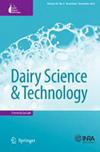Postprandial Glycaemia, Insulinemia, and Lipidemia after 12 Weeks’ Cheese Consumption: An Exploratory Randomized Controlled Human Sub-Study
Q2 Agricultural and Biological Sciences
引用次数: 0
Abstract
Some populations are recommended to consume low-fat dairy, although the evidence behind replacing high-fat with low-fat dairy products is limited. This exploratory sub-study investigated the effect of cheese with different fat content on postprandial changes in type-2-diabetes risk markers. Following 12-week cheese or jam intake, a 4 h meal test was conducted with 37 participants. Test meals included bread and either: 80 g regular-fat cheese (REG), 80 g reduced-fat cheese (RED) or 25 g jam (CHO). Postprandial blood was drawn and appetite sensations registered. Time-meal interactions were not observed for glucose and insulin, but for triglycerides (TG) and free fatty acids (FFA). Pairwise comparisons showed 0.17 ± 0.07 mmol/L (p = 0.044) and 0.25 ± 0.07 mmol/L (p = 0.002) higher TG at 180 and 240 min, respectively, and 94 ± 37 mmol/L (p = 0.029) higher FFA at 180 min for REG compared with RED. Compared with CHO, intake of both cheese meals reduced insulin and glucose (main effects of meal, both p ≤ 0.011) and increased FFA and TG at certain time points. In conclusion, intake of cheese with a regular, compared with reduced, fat content did not affect glucose, insulin and appetite, but increased TG and FFA.食用奶酪12周后餐后血糖、胰岛素和血脂:一项探索性随机对照人类亚研究
一些人群被建议食用低脂乳制品,尽管用低脂乳制品代替高脂乳制品的证据有限。本探索性亚研究探讨了不同脂肪含量的奶酪对餐后2型糖尿病风险标志物变化的影响。在吃了12周的奶酪或果酱后,对37名参与者进行了为期4小时的膳食测试。测试餐包括面包和80克正常脂肪奶酪(REG)、80克低脂奶酪(RED)或25克果酱(CHO)。餐后抽血,记录食欲。葡萄糖和胰岛素的时间-餐相互作用未被观察到,但甘油三酯(TG)和游离脂肪酸(FFA)的时间-餐相互作用被观察到。两两比较显示,与RED相比,REG在180和240 min时TG分别升高0.17±0.07 mmol/L (p = 0.044)和0.25±0.07 mmol/L (p = 0.002), 180 min时FFA升高94±37 mmol/L (p = 0.029)。与CHO相比,在某些时间点,两种奶酪餐的摄入均降低了胰岛素和葡萄糖(p≤0.011),增加了FFA和TG。综上所述,与减少脂肪含量相比,定期摄入奶酪对葡萄糖、胰岛素和食欲没有影响,但会增加TG和FFA。
本文章由计算机程序翻译,如有差异,请以英文原文为准。
求助全文
约1分钟内获得全文
求助全文
来源期刊

Dairy Science & Technology
农林科学-食品科技
CiteScore
2.30
自引率
0.00%
发文量
0
审稿时长
2 months
期刊介绍:
Information not localized
 求助内容:
求助内容: 应助结果提醒方式:
应助结果提醒方式:


